Tart, sweet and salty with great crunch, these quick pickled radishes are easy to make. The pickling process needs a minimum of 8 hours, but prep is quick and they make a great condiment for sandwiches or salads. Because these are not canned or heat processed, they must stay refrigerated and should be consumed within 1-2 weeks.

Jump to:

Why you should try this
Quick pickling is a time saving method of preserving that essentially uses vinegar to brine and preserve food. There's no lengthy fermentation period or heat processing involved with this method. Quick pickles are also called refrigerator pickles—as their name implies, they need to stay in the fridge and can't be stored on the pantry shelves unlike heat processed or canned pickles. Overall, this recipe for quick pickled radishes is simple to prepare and will enhance your salads or sandwiches with a great tangy crunch. They're also great on their own.
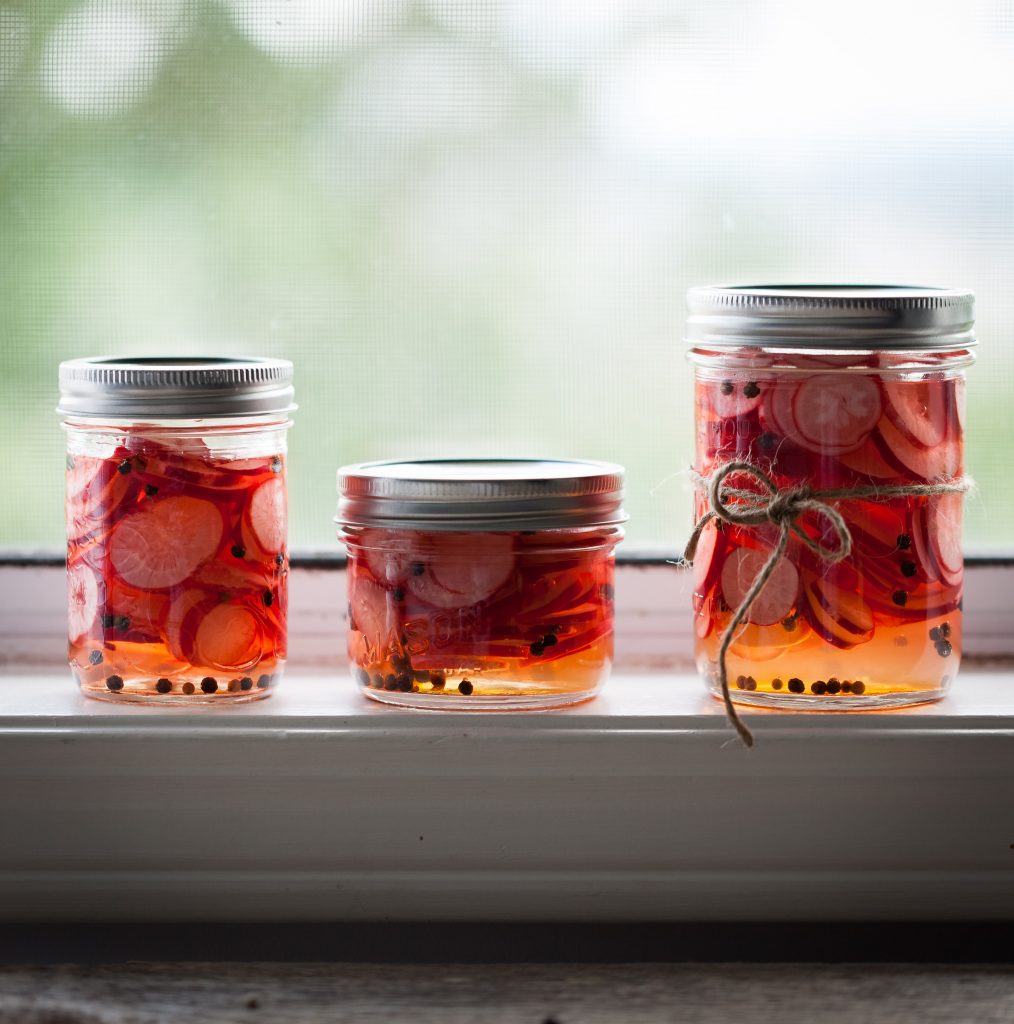
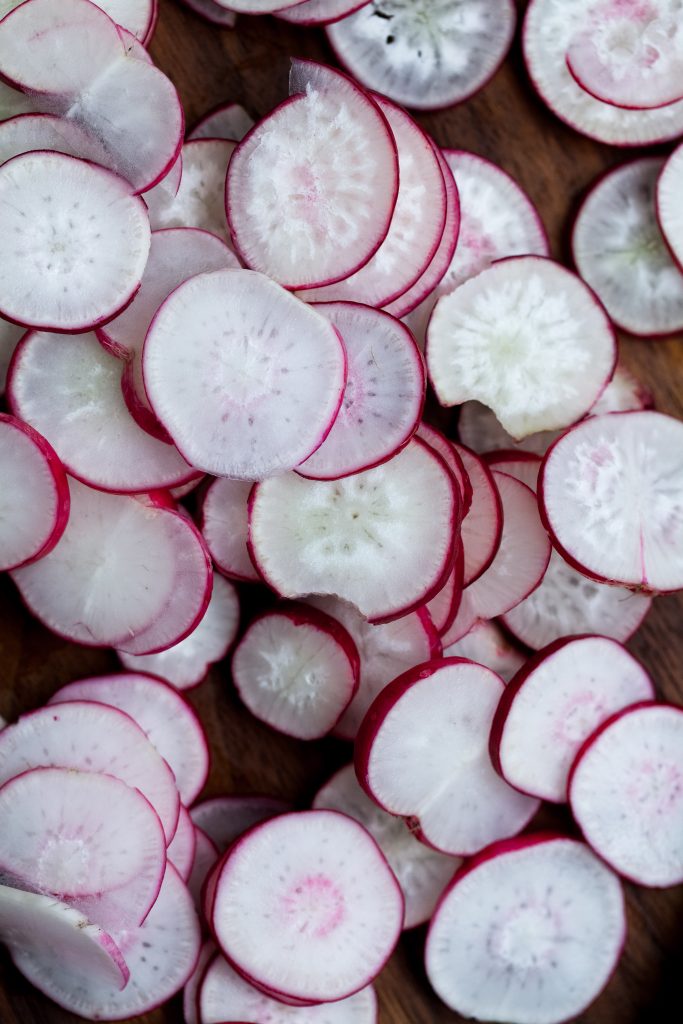
Ingredients & Equipment Overview
For this recipe, you'll need several supplies and a few basic ingredients as follows. For the full detailed ingredients and quantities of each, please see the recipe card.
Equipment
- sterilized mason jars, lids and rings
- Sterilized knife and cutting board
- Small saucepan and spoon
- Optional: pickling weight
Ingredients
- Fresh radishes, washed, leaves and stem end removed
- Black peppercorns
- White pickling vinegar (7% acetic acid)
- Filtered water
- Organic cane sugar
- Pickling or kosher salt
- Optional: garlic cloves and mustard seeds
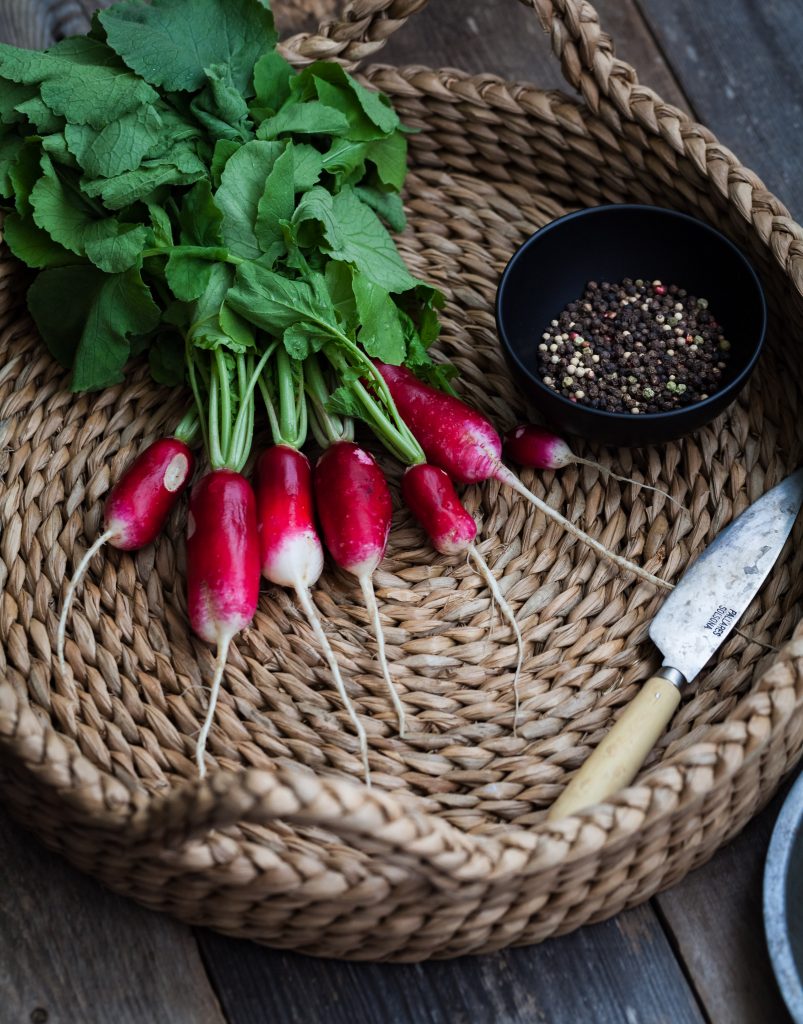
Step by Step Overview
For the full detailed instructions, please see the recipe card. There are also important safety notes and helpful hints below, so please read this post in full before attempting this recipe.
STEP 1: Sanitize the jars, lids and equipment.
STEP 2: Divide the peppercorns and any optional seasonings evenly into each sterilized jar.
STEP 3: Slice the radishes and tightly pack them into the jars.
STEP 4: In a medium pot, bring the vinegar, water, sugar, and salt to a boil and stir until the sugar and salt are dissolved.
STEP 5: Carefully pour the hot brine into each jar until just covering the radishes.
STEP 6: Put on the lids and screw on the rings.
STEP 7: Let the jars cool to room temperature then place them in the fridge for minimum 8 hours before consuming.

Helpful Tips
Choose the best radishes- great quick pickles start with great ingredients. You want to choose quality radishes that are firm, bright red (if using french breakfasts), and are about 1" in diameter with no discoloration, dark spots or other indications of spoilage on them. Discard any radishes with any signs of spoilage, blemishes or imperfections.
Sterilize- all equipment and tools should be washed and sterilized thoroughly and then dried completely. This step helps to prevent any possible contamination. Also be sure to wash your hands thoroughly.
Wash the produce - again this will help prevent possible contamination and help remove any unwanted pesticides or residues.
Thinly slice the radishes - I like to keep them roughly ⅛ or 1/16 of an inch to help them pickle and yield better flavour.
Don't alter the brine ingredients - a high level of acidity is required to make sure the radishes pickle correctly and to help prevent contamination.
Make sure the brine is heated and mixed properly - A uniform acidity is required to help ensure the radishes pickle correctly to help prevent contamination.
Tightly pack and fully immerse in the brine - it's critical that the radish slices stay submerged in the brine in order to pickle properly. Tightly packing them will help prevent any from floating upwards; any pieces that are not fully in brine may develop mold or bacterial growth and compromise the jar.
Leave headspace -leaving a ½ inch of space left at the top of the jar will help make sure you have enough room to fully submerge the radishes and prevent any brine from overflowing or getting around the lid and ring.
Allow 8 hours for pickling - I leave the radishes for a minimum of 8 hours in the fridge before enjoying them; their flavour is best after this amount of time.
Store in the fridge - these quick pickled radishes need to stay refrigerated because there is no canning/heat processing involved- this recipe is NOT shelf stable. I also suggest making a note of the date you prepared them and keeping it on hand for reference.
Use a pickle weight if needed - if you radishes are not staying submerged in the brine, you can use a pickle weight which an be found where pickling supplies can be purchased.
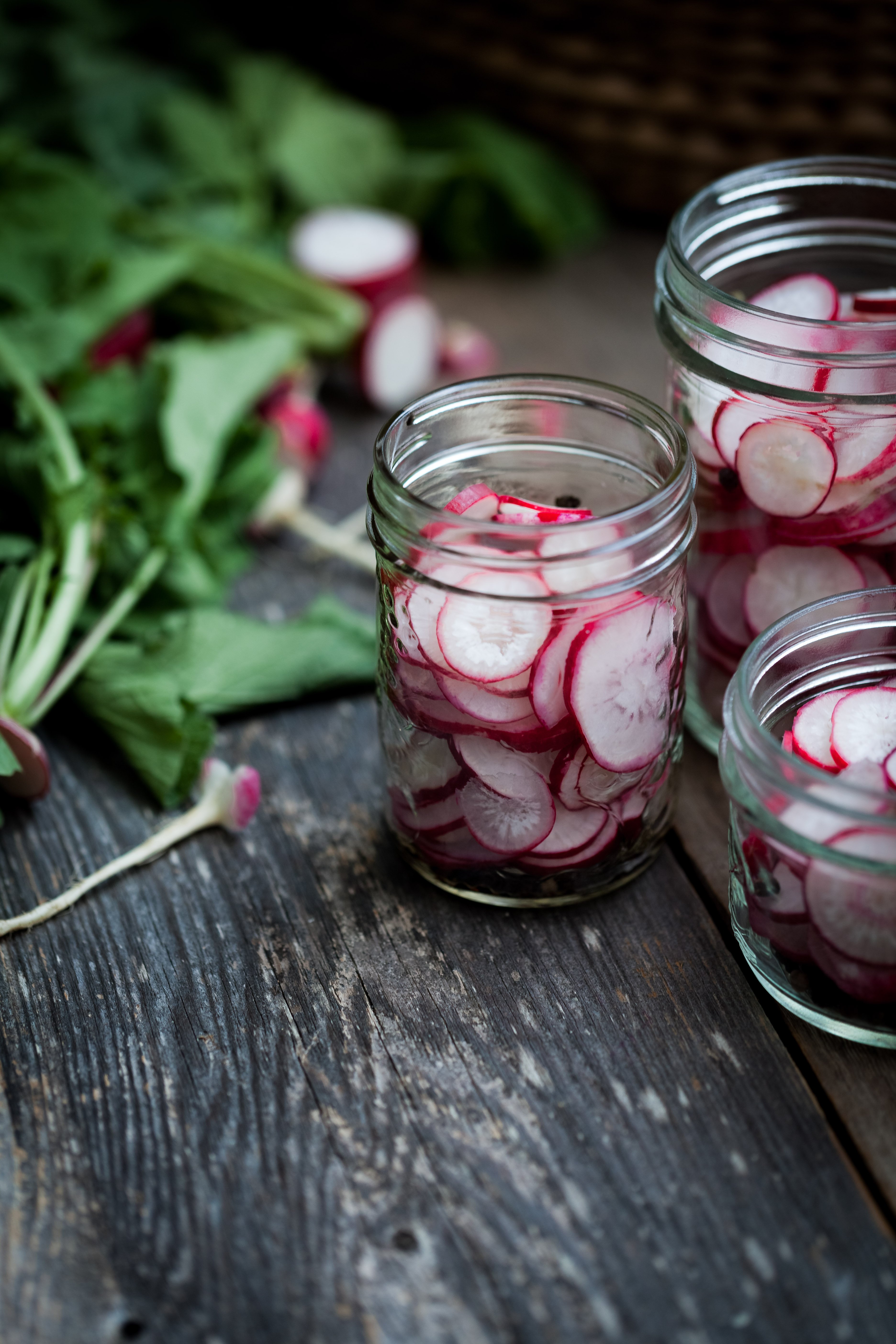
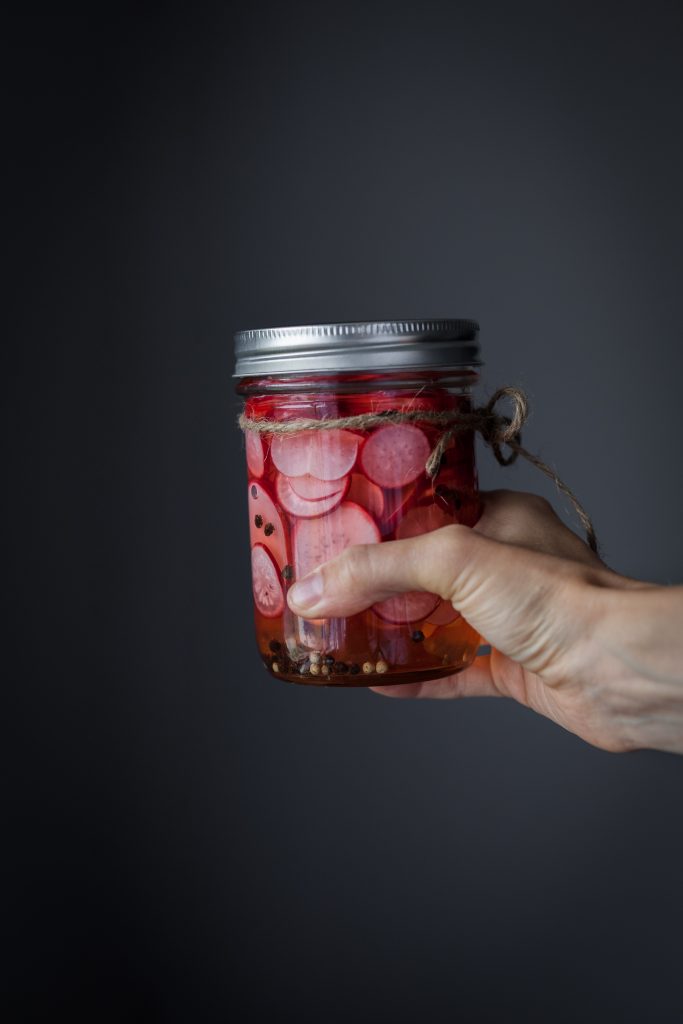
Storage
Quick pickled radishes are best eaten within 1-2 weeks. If you note any cloudiness, mold, fizzy bubbles, slime, or otherwise indications of spoilage discard the recipe right away. Quick pickles are generally quite safe to eat, however, use your best judgement and when in doubt, discard.
Serving Suggestions
Some of the ways I enjoy using these quick pickled radishes are salads, tacos, charcuterie boards, burger or sandwich toppings, as a small side.
Important Safety Notes
If you're new to the science of pickling and preservation, I recommend reading up on the topic (some resources below). As with any preservation method, it's important to familiarize yourself with best practices for avoiding contamination and knowing when a pickle may not be safe to eat.
All pickles carry some risk of food poisoning caused by bacteria, however, quick pickles are generally quite safe to eat. Always use your best judgment; if you note any cloudiness, mold, fizzy bubbles, slime, or otherwise indications of spoilage discard the quick pickled radishes right away. And if you're ever in doubt, discard and don't take a chance.
Furthermore, you may want to be cautious when consuming pickles if you are pregnant, have a compromised or weakened immune system etc. Also, to be extra cautious, I prefer to keep these just for my husband and I, and not for our children.
Frequently Asked Questions
No. This recipe has not been tested for safety with canning as it was designed to be a refrigerator/quick pickle recipe. If you want heat processed/canned pickled radishes, please follow a recipe specifically designed for that purpose.
There are only two main methods to for pickling: salt-water brining (lacto-fermenting) or immersion in vinegar solution (quick pickling). Both methods are great, but have some differences. In short, salt-water brining (lacto-fermenting), involves beneficial bacteria converting a foods natural sugars and starches into lactic acid- this forms an acidic and probiotic-rich brine which prevents food spoilage.
Vinegar pickling (quick or sometimes referred to as refrigerator pickling), uses an already acidic solution (vinegar) to create an optimal preserving environment. While the vinegar method lacks the beneficial bacteria and depth of flavour of fermentation, the process considerably faster and also produces a crunchy flavourful pickle. If lacto-fermentation seems intimidating, try the vinegar or quick-pickling method.
Pickling Resources
Pickling has a long history and was an important means of preserving food before refrigerators and freezers became common place. These are a few of my favourite pickling and preserving resources. I suggest reading up on the fascinating art and science of pickling and learning more about at home pickling and safety.
National Center for Home Preservation
The Art of Fermentation- Sandor Ellix Katz
Ball Complete Book of Home Preserving - Judi Kingry
Preservation: The Art and Science of Canning, Fermentation and Dehydration- Christina Ward
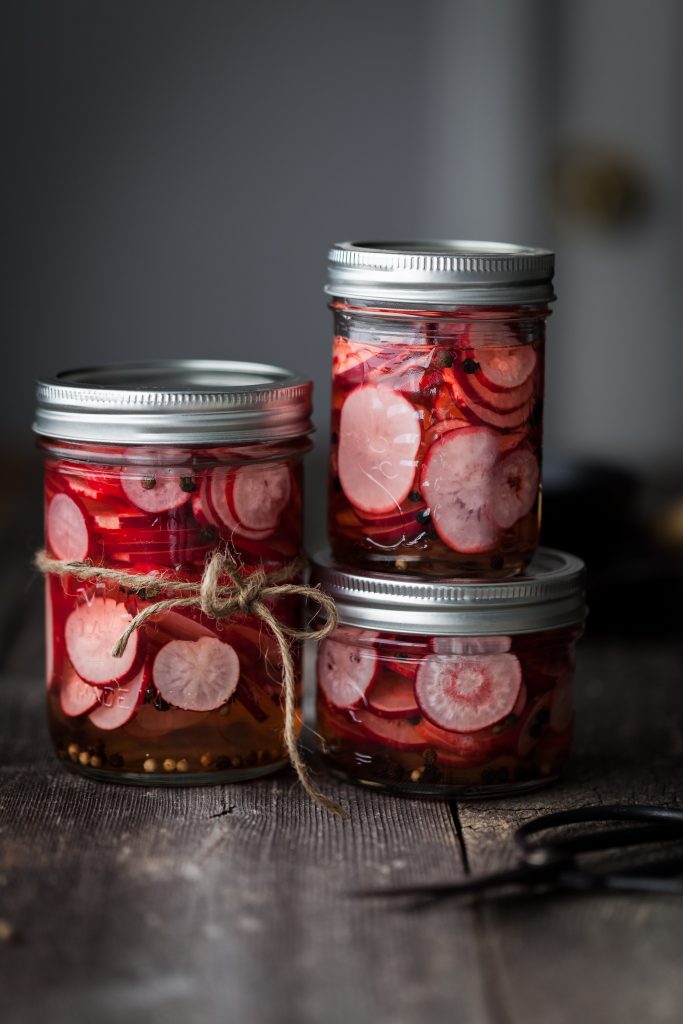
More Recipes
Here are a few other recipes featuring radishes, pickles or great sandwiches to add these quick pickled radishes to!
Easy Quick Pickled Green Beans
Pickled Red Onions from Occasionally Eggs
If you made my quick pickled radishes please leave me a comment below with a star rating; it really helps others who are interested in making the recipe. For more from The Simple Green, follow me on Instagram, Facebook or Pinterest. Consider becoming a subscriber to receive emails of new recipes and posts.

Easy Quick Pickled Radishes
Special Equipment
- 3- 250ml mason jars with lids and rings
Ingredients
- 350 grams (approx. 3 cups) Radishes, well washed, stem and leaves removed
- 1 tablespoon peppercorns
- 2 cups white pickling vinegar, 7% acetic acid
- ½ cup filtered water
- ⅓ cup organic cane sugar
- 1 teaspoon pickling salt
Optional
- 2 garlic cloves, peeled
- 2 teaspoon mustard seed
Instructions
Prep the Jars and Radishes
- Using hot soapy water, carefully clean 3- 250ml mason jars with lids and rings. Place the jars, lids and rings in a large pot and carefully pour boiling water over them to cover. Allow to sit for 5 minutes, then using tongs and heatproof gloves, carefully remove the jars, lids and rings from the water, discard any excess, and allow them to dry completely. Make sure all other equipment are thoroughly cleaned.
- Divide the peppercorns and any optional seasonings evenly into each sterilized jar. Set aside.
- Slice the radishes ⅛ inch thick and tightly pack them into the jars. The radishes should be packed tight enough that they won't float once brine is added.
Prepare the brine
- In a medium pot, bring the vinegar, water, sugar, and salt to a boil and stir until the sugar and salt are dissolved. Using a canning funnel, carefully pour the brine into each jar until just covering the radishes, leaving a ½" of headspace. The radishes should all be immersed in brine.
Cool and store in the fridge
- Put on the lid and screw on the rings. Let the jars cool to room temperature then place them in the fridge for minimum 8 hours before consuming, preferably overnight.
Notes
Nutrition
This is an approximation of the nutrition offered in this recipe, and is created using a nutrition calculator. I am not a nutritionist and cannot guarantee accuracy. If your health depends on nutrition information, please calculate again with your preferred calculator.
Disclaimer
all recipes on The Simple Green are developed and tested in a Canadian kitchen, at normal elevation, using electric appliances and ingredients available in Canada. Results may vary.

Awesome recipe Heidi. Like many food gardeners, I often succumb to the feast-or-famine syndrome. Especially when it comes to radishes. I always sow too many at once. Leaving me with a glut, followed by weeks without any. Now I can preserve the abundance when they are at their best.
Ah perfect 🙂 I'm really happy to hear you like the recipe. Thank you so much for letting me know!
These are heavenly! Our whole family loves these, they are go good to snack on, use in sandwiches and salads, and on delicious charcuterie boards. Thank you for sharing these!
I’m so happy to hear the feedback, Sydney! Thank you for sharing and for making my recipe 🙂
Is it ok to water bath these so they keep longer? If so, what would the processing time be?
Hi Teresa! That's a great question and unfortunately, I'm not entirely sure. I haven't developed this recipe to be water bathed. There are recipes specifically for canning pickled radishes, which I would use instead.
Why sterilize the jars if it is a quick pickle?.. i'm not an expert but I don't think you have to if refrigerated..
Hi Katy! I know several recipes don't call for sterilizing, however, I like to take this extra step to help reduce the chance of the contents spoiling.